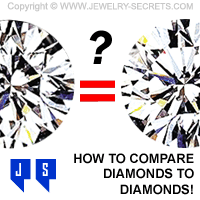COMPARING JEWELERS AND DIAMOND PRICES
HOW TO COMPARE DIAMONDS TO DIAMONDS AND THEIR DIAMOND PRICES!
This post contains affiliate links. If you use these links to buy something I may earn a commission. Thanks! As an Amazon Associate I also earn from qualifying purchases.

When will customers learn?
They wander around the store and finally ask me for the price of a diamond in the jewelry showcase. I tell them. Then they say that they saw the same ring down the street at so-and-so jewelers for half the price!
I can see it in their eyes…
“What a rip-off!”
They look at me like I’m trying to pull a fast one. So I ask them a couple of questions: “Do you know what the clarity of the competitor’s diamond is?“
The customer says “No”
“Do you know what the color is?” Again the customer says “No“.
“Do you know if it’s properly proportioned or cut well?” “No!“
“Do you know if the diamond is certified?”
“NO!”
Come on, how are you supposed to compare diamonds to diamonds when you don’t know any of this must-have information? If all you get is carat-weight and price, then you’re about to make some really bad decisions and more than likely get ripped off for real.
How to compare:
To compare diamonds to diamonds and prices, you really need to know all of the facts. You can’t blindly pick one or two of the 4 C’s and think that all diamonds should be in the same category.
All 1.00 carat diamonds do not cost the same. Just like a basic KIA verses a fully loaded BMW…
They’re not the same!
So much more affects the price than just carat weight. You have to get the exact cut, color, and clarity. You really need to know if it’s certified, as well as WHO certifies it. That’s a big difference. GIA is the best, but usually costs more.
You should know if the diamond you’re looking at is a shallow or deep cut diamond. Whether it has extra facets on it. Does the diamond have fluorescence? What about the table and crown percentages, angles and even the thickness of the diamond girdle? There’s so much more that adds to the price. Simply comparing one piece of the puzzle does nothing but confuse you.
So how do you really compare diamonds to diamonds?
What do you really look for when comparing different diamonds at different jewelers? After all, the prices seem all over the board… A one carat (1.00) brilliant-cut diamond could sell anywhere from $2,300 to $20,000 (take a look). That’s a crazy difference. How is one ever really going to know if they’re being ripped off or not?
Well, here’s what you look for…
Clarity:
Look for a clarity that’s pleasing to the eye. Normally if you get a diamond with an SI1 clarity you’ll be getting a great looking diamond at a halfway decent price. I’m not going to kid you there, SI1 clarity diamonds are not the cheapest diamonds available, they are middle of the line, but the look and sparkle you get from them are worth every penny.
Color:
Get a color no less than H (G color is better). But H color and up (D-E-F-G) are great colors to choose from. G-H are considered a fine white colors in the Near Colorless range. And D-E-F are the highest color grades on the market. They are actually considered pure white. Pure white means there is no color whatsoever. So getting a color that’s white (D-E-F-G-H) actually adds a lot of brightness and life to a diamond. Plus a good color can make up for a lower quality diamond and help hide inclusions, too.
Cut:
Cut is a little bit harder to understand. There is a lot going on with the angles and proportions. But if you find a diamond that’s an “excellent” cut diamond, you’ll be getting a beautiful looking diamond full of fire and brilliance, and that’s something you won’t ever regret. Read more about the 4C’s of diamond grading HERE.
Certification:
This last one is so important… Buy a diamond that’s been certified by the best certificate diamond appraiser in the World; GIA. I can’t stress how important it is to get a diamond graded by them. GIA is the Gemological Institute of America. Trust me when I say… They are the leaders in the diamond industry. They wrote the book on diamonds. GIA certified diamonds guarantee that you’re really getting what you paid for. I wouldn’t buy a diamond that wasn’t GIA certified (aka, diamond report).
So if you’re comparing diamonds to diamonds, make sure you’re comparing GIA certified diamonds to GIA certified diamonds. Get a Near Colorless diamond like G, H, or HIGHER, get a diamond with a clarity rating of SI1, or HIGHER, and if you can get a great cut that’s excellent (very good at the least), you’ll love it.
Only then you’ll know that you got yourself a really great deal.
And a really great diamond!
Cheers! :)














Leave a comment